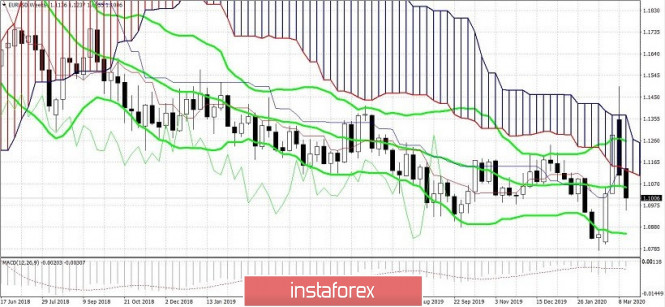Bears of the euro-dollar pair could not gain a foothold in the area of the ninth figure, although yesterday the price was in this area throughout the US session. But during the Asian session on Wednesday, the bulls took the initiative and tried to go above the strategically important 1.1050 mark (the average line of the Bollinger Bands indicator, which coincides with the upper border of the Kumo cloud on the daily chart). According to a number of currency strategists, if buyers manage to settle above the target today, the pair will form a short-term price low. At least now it is obvious that the price area below the 10th figure is quite difficult for sellers of EUR/USD, despite the overall hegemony of the dollar. This price rebound, which has all the signs of a correction, is due to several factors-both fundamental and technical. But in any case, it should be remembered that the pair is still within the downward trend and will remain as long as the dollar is the beneficiary of panic in the market.

But first of all, let's understand why the euro-dollar pair unexpectedly turned around, despite the dominance of anti-risk sentiment in the financial markets. Strangely enough, the macroeconomic releases still managed to attract the attention of traders. Although, as a rule, during periods of such shocks, economic reports go to the second or third plan, awaiting their hour. But yesterday we witnessed an exception to the rule: both the European and US currencies were under pressure from their respective reports. Initially, the euro came under pressure from disappointing figures: the ZEW indices of Germany and the eurozone came out not only in the red zone, but also updated multi-year lows. The German index fell to -49 points with the forecast of a decline to -29 points. The pan-European indicator showed similar dynamics, falling to almost -50 points, while the forecast for a decline to -23 points. The indicators fell to their lowest values since 2010, reflecting the pessimism of the European business environment.
A little later, US data were published – no better: the overall retail sales index fell into negative territory for the first time since September last year, reaching -0.5% m/m. Excluding car sales, the indicator showed a similar dynamics, falling to -0.4% (the worst result since December 2018). Sales excluding auto and fuel sales also sharply fell (this indicator fell to the lowest in February 2019).
At first, the US currency ignored this data – the dollar index was rapidly increasing amid a decline in stock markets and a wave of general panic. But the dollar index slowed its momentum after testing the hundredth figure. The degree of heat in the markets slightly fell after the optimistic statements of Donald Trump, who said that there is "already progress"in the fight against the coronavirus. He also assured Americans that the White House will support small businesses and coordinate additional stimulus measures with the Senate.
As soon as the anti-risk sentiment in the market slightly weakened, the dollar's position was shaken. This is an important point that indicates the potential vulnerability of the US currency. As soon as the hysteria with the coronavirus fades, the greenback will lose a serious trump card for its growth, while the uncorrelation of monetary policies of the Fed and ECB may provide additional support to the EUR/USD bulls. By the way, according to the representative of the European Central Bank, Robert Holzmann (head of the central bank of Austria), the monetary policy of the regulator "has already reached its limits", while the crisis can have a "cleansing effect on the economy of the eurozone."
However, despite the small price rebound of EUR/USD, it should be remembered that the pair is under strong pressure of panic moods. The dollar did not retreat, but only temporarily slowed down. The number of infected and dead continues to increase around the world, with Europe becoming the epicenter of the epidemic. But in the Chinese province of Hubei, which was previously the focus of the pandemic, only one case was detected over the past day. On the one hand, this suggests that the coronavirus can be brought under control, on the other hand, everyone understands that Europe is not China, and it will be more difficult to curb the epidemic in European countries. In addition, in association with COVID-19: many airlines are on the verge of bankruptcy, and the tourist industry is actually dying out. Next – the domino effect, which will affect the rest of the economy of the eurozone. Chinese data published on Monday illustrated the possible consequences of the pandemic quite clearly.

Thus, there are no prerequisites for a reversal of the EUR/USD trend at the moment. Moreover, if buyers are not able to gain a foothold above 1.1050 in the near future, the pair will not only return to the ninth figure in the medium term, but also test the eighth price level. And although the bears feel quite uncomfortable below the 10th figure (so far), the ongoing panic will allow them to open new price horizons for themselves.
From a technical point of view, the situation also indicates the priority of the bearish movement. On the weekly chart, the price is located on the middle line of the Bollinger Bands indicator, which indicates the current uncertainty. At the same time, the pair is under the cloud of the Kumo indicator Ichimoku – and this combination indicates the prospect of price reduction. The goal of the downward movement is the above-mentioned mark 1.0850 – this is the lower line of the Bollinger Bands indicator on W1. The resistance level is the price of 1.1105, which corresponds to the lower boundary of the Kumo cloud on the same timeframe.
The material has been provided by InstaForex Company - www.instaforex.com